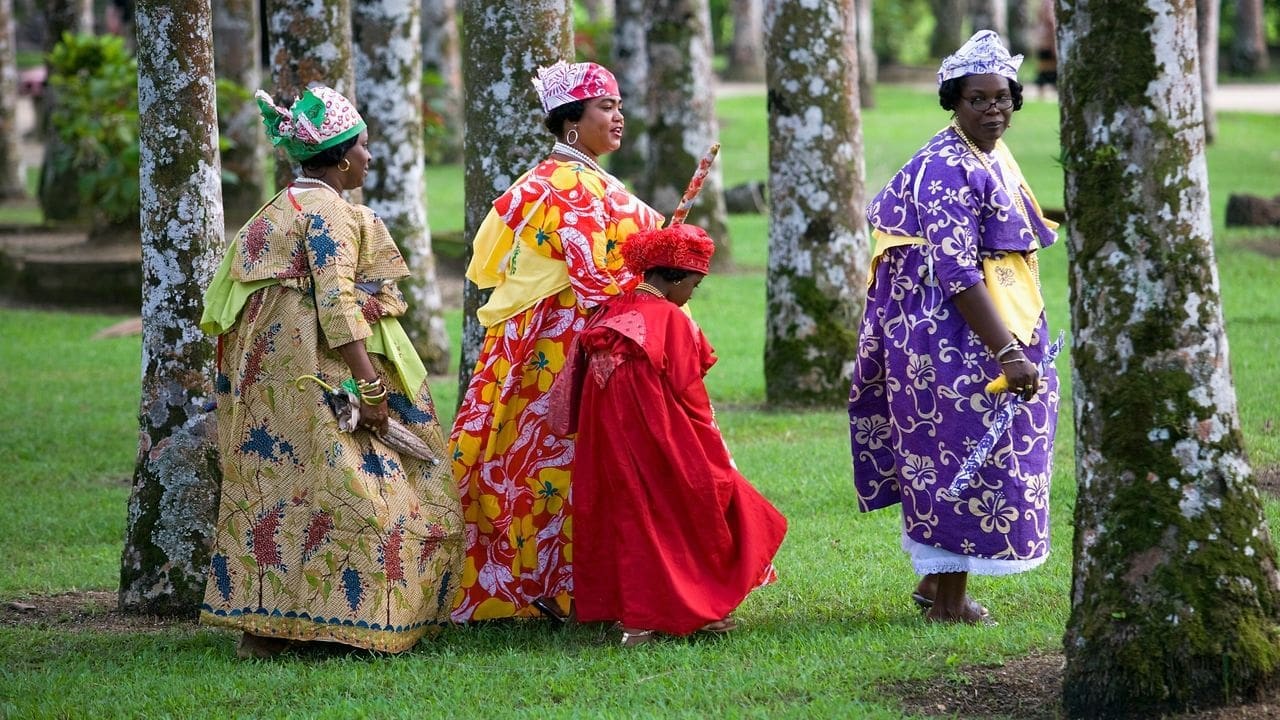Surinam has a rich history in South America, a heritage often expressed in its textiles. The Great Suriname Exhibition at the Nieuwe Kerk in Amsterdam now displays some of this heritage.
The indigenous peoples of Suriname harvested their own cotton, spun the resulting textiles and then dyed them with natural dyes. The blue cotton skirt and shawl of a Lokono lady (late 19th-20th century) are on view, along with some cotton Karina loincloths (pre-1912) and beautiful hair and arm ornaments crafted from feathers, crystals, palm leaves and other materials (late 19th to early 20th century).
KOTO
The koto, a large skirt or dress made of printed cotton, worn by Creole-Surinamese women with a short jacket and an angisa, or head scarf, is perhaps Surinam’s most iconic outfit. There are hundreds of ways of folding an angisa, which are mostly used to convey the thoughts or views of the wearer. The koto’s official history dates back to 1879, when the Dutch colonial government mandated that women would wear a dress or paantje (chest cover) and a jacket or gown when outside. There are several kotos on show, from various time periods, now worn mainly on festive occasions.
All of that and more a koto misi outfit will do. There is a mysterious significance behind each piece of silk, every vivid pattern, every fold in a headscarf. And Christine Van Russel-Henar is revealing the hidden codes of Afro-Surinamese women’s fashion at the Het Koto Museum in Suriname.
One of the first things you’ll see is a snapshot of Van Russel-mother, Henar’s grandma and great-aunt in koto outfits from around the 1920s. Enter the unassuming house on a residential street in central Paramaribo. They wear wide dresses, formal coats and headscarves, as do the mannequins in the exhibit. Van Russel-Henar states that free women of colour in Paramaribo wore these costumes as an expression of defiance and modesty before emancipation in 1863: “They said,’ Let the people know this is mine,'” with the vast quantities of cloth and jewels that enslaved women were prohibited to wear. The outfits, known only by other ladies, started to have hidden meanings.
Afro-Surinamese women used mashed cassava and water as starch to mould cloth into angisa (headscarves), folded at the back of the head to make a kind of hat. The odo (pattern names) were phrases such as The garbage truck gathers garbage but not guilt” and I’m a grown woman in my own home, I can do as I like,” while the folding might mean, “Keep your tongue,” “Wait for me at the corner,” or Let them speak.” The big skirt was even starched with cassava, part of the koto: It’s way too hot to wear an underskirt in the tropical heat of Suriname.
The koto’s origin is uncertain. But hypotheses about big outfits vary from the effort at modesty by the Moravian church to women’s defence from the male gaze to a show of pride in being able to afford fabrics. Women were also known to go topless in Suriname, and some legend suggests that the koto was a part of the envy of the slave-owner mistress, causing the coverup of enslaved women.
PANGI
In the traditional clothes of the Maroons, enslaved individuals who fought their way to independence, signs of Suriname’s African roots can be found. Maroons fled plantations in the interior of Surinam and established their own societies. One of the most remarkable shows is that of the long rectangular fabric worn by Maroon women around their waist with over two dozen pangi. Her transition from girl to adult was usually indicated by a woman’s first pangi. Pangi can now be dated based on designs, often offered as a gift to a girlfriend (and made from fabric purchased in Paramaribo). Pangi from the 19th to the 21st centuries are seen on the board. At the end of the 19th century, patchwork pangi was popular, while in the 1920s it became fashionable to stitch narrow strips of differently coloured fabric together. In the 1970s, after studying cross stitch in mission schools, younger women started to decorate their pangi with non-linear, cross stitched patterns.
Pangis also features in a piece of art by Marcel Pinas. A long dining table was deliberately arranged for 38 guests in a style reminiscent of Judy Chicago’s ‘The Dinner Party’. A specially crafted black and white pangi is drapped over each chair. The piece called “Moiwana 86 Tafas,” commemorates the murders during the Civil War of Surinam (1986-1992) of 38 Maroon villagers.
A poem about rain written on long white cloth draped and adorned with Indian bangles is another textile art work by Razia Barsatie. Indian saris and dhotis, and Javanese sarongs represent the East Indian origins of the region. Seven finely carved wooden hair combs are also on show, made by both women and men.
The European history of Surinam is not ignored. A long sleeved gown in green silk, with beads and spangles, with compliments from the Royal Collection in the Hague, is available on the floor. This was the dress worn by Princess Beatrix in 1975, during ceremonies marking the independence of the republic, in Paramaribo’s stadium when the Surinam flag was hoisted. Although this is not a textile show, there are several textiles to be shown until 2 February 2020 at The Great Suriname Exhibition.

